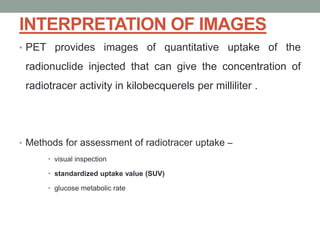This document discusses SPECT and PET imaging. It explains that radionuclides are produced artificially and decay via processes like beta decay, producing gamma rays. SPECT uses gamma camera systems to produce 3D functional images, and is affected by factors like photon attenuation. PET involves injecting a radiolabeled tracer like FDG and detecting coincident gamma rays to locate the tracer distribution. Common clinical applications of SPECT and PET imaging include evaluating glucose metabolism in neurology, cardiology and oncology.



























![SYNTHESIS OF F-18 &FDG
• Over 500 PET compounds have been synthesized since
1970.
• Natural substrates such as amino acids, analogues
,fluorinated glucose &drugs.
• MC used is a glucose analogue, 2-[F18]fluoro-2-deoxy-D-
glucose (FDG).](https://image.slidesharecdn.com/spectpetlast-161206183619/85/spect-and-pet-28-320.jpg)

![USES
Fluorodeoxyglucose
[18F]-labeled 2-deoxyglucose (FDG) is used in neurology,
cardiology and oncology to study glucose metabolism. FDG is
potentially useful in differentiating benign from malignant forms
of lesions because of the high metabolic activity of many types
of aggressive tumors.
Oxygen
[15O]-labeled water is used to evaluate myocardial oxygen
consumption and oxygen extraction fraction. It can also be used
to measure tumor necrosis.](https://image.slidesharecdn.com/spectpetlast-161206183619/85/spect-and-pet-30-320.jpg)
![• Ammonia
[13N]-labeled ammonia can be used to measure blood
flow.
• Leucine
[11C]-labeled methionine and leucine can be used to
evaluate amino acid uptake and protein synthesis,
providing an indicator of tumor viability.
• Fluorine Ion
Radiolabeled fluorine ion [18F-] was once a standard
agent for clinical bone scanning.](https://image.slidesharecdn.com/spectpetlast-161206183619/85/spect-and-pet-31-320.jpg)









































